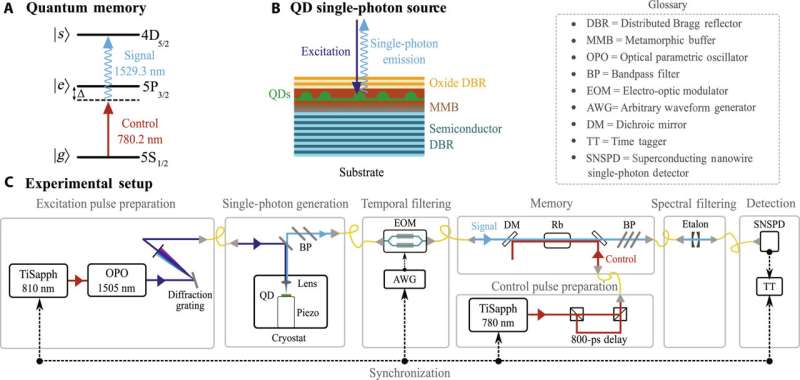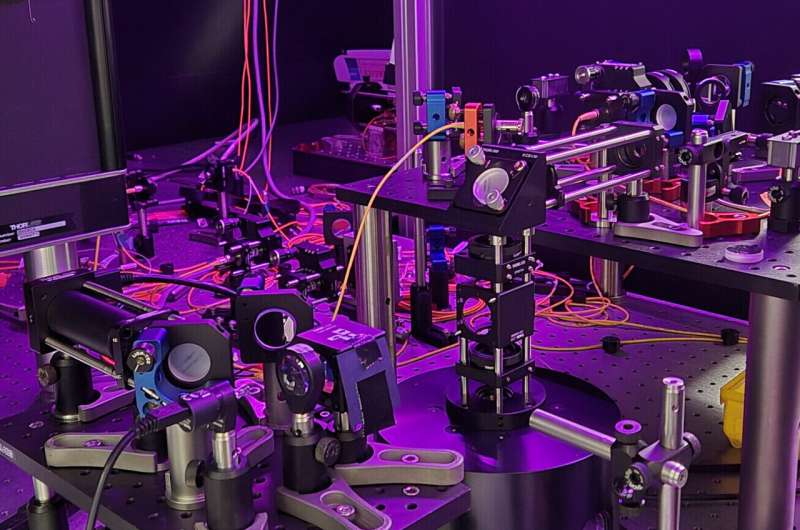The team’s quantum dot setup.Image source: Imperial College London
Researchers have generated, stored and retrieved quantum information for the first time, a key step in quantum networking.
The ability to share quantum information is critical to developing quantum networks for distributed computing and secure communications. Quantum computing will help solve important types of problems, such as optimizing financial risks, deciphering data, designing molecules and studying materials properties.
However, this development has been hampered by the fact that quantum information can be lost when transmitted over long distances. One way to overcome this obstacle is to break the network into smaller parts and connect them all with shared quantum states.
To do this requires a way to store quantum information and retrieve it again: a quantum storage device. It must first “talk” to another device that allows the creation of quantum information.
For the first time, researchers have created such a system that connects these two key components and uses conventional optical fibers to transmit quantum data.
The feat was achieved by researchers from Imperial College London, the University of Southampton, and the Universities of Stuttgart and Würzburg in Germany, with the findings published in scientific progress.
Co-first author Dr Sarah Thomas, from the Department of Physics at Imperial College London, said: “Connecting two key devices together is a crucial step towards realizing quantum networks and we are delighted to be the first team to achieve this. To be able to demonstrate at this point.
Co-first author Lukas Wagner from the University of Stuttgart added: “Allowing remote locations and even quantum computers to be connected is a key task for future quantum networks.”
long distance communication
In conventional telecommunications, such as the Internet or phone lines, information can be lost over long distances. To solve this problem, these systems use “repeaters” at fixed points that read and re-amplify the signal, ensuring it reaches its destination intact.
However, classical repeaters cannot be used with quantum information because any attempt to read and copy the information will destroy it. This is somewhat of an advantage, since quantum connections cannot be “eavesdropped” without destroying the information and alerting the user. However, this is a challenge that long-distance quantum networks need to solve.

Schematic diagram of the experimental setup for QD quantum memory interface. (B) Scheme of a semiconductor QD sample with semiconductor bottom DBR, metamorphic buffer (MMB), and oxide top DBR. (C). Experimental setup of a hybrid interface for storing photons from QD single-photon sources in quantum memory. Credit: scientific progress (2024). DOI: 10.1126/sciadv.adi7346
One way to overcome this problem is to share quantum information in the form of entangled particles of light, or photons. Entangled photons share properties in a way that makes it impossible to understand one but not the other. To share entanglement over long distances in a quantum network, you need two devices: one to create entangled photons, and another to store them and allow them to be retrieved later.
There are several devices used to create quantum information in the form of entangled photons and store it, but researchers have long been elusive in generating these photons on demand and having compatible quantum memories to store them.
Photons have certain wavelengths (which produce different colors in visible light), but the devices used to create and store photons are often tuned to use different wavelengths, preventing them from connecting to each other.
To implement the device interface, the team created a system in which two devices use the same wavelength. “Quantum dots” generate (non-entangled) photons and then pass them to a quantum storage system, which stores the photons in a cloud of rubidium atoms. The laser can turn the memory “on” and “off” so that photons can be stored and released as needed.
The wavelengths of the two devices not only match, but are identical to those of telecommunications networks in use today, allowing transmission over the regular fiber optic cables familiar from everyday internet connections.
European cooperation
This quantum dot light source was created by researchers at the University of Stuttgart with support from the University of Würzburg, and was then brought to the UK to be connected to a quantum storage device created by the Imperial College and Southampton teams. The system was assembled in a basement laboratory at Imperial College London.
While standalone quantum dots and quantum memories have been created that are more efficient than the new system, this is the first evidence that devices can interface at telecommunications wavelengths.
The team will now look to improve the system, including ensuring that all photons are produced at the same wavelength, extending the storage time of the photons, and making the overall system smaller.
However, as a proof of concept, it is an important step forward, said co-author Dr Patrick Ledingham from the University of Southampton. “Members of the quantum community have been actively trying to make this connection for some time. This includes us, who have tried this experiment twice before with different memories and quantum dot devices, dating back more than five years, and this just goes to show. How difficult it is to do this”.
“The breakthrough this time was in bringing together experts to develop and run each part of the experiment using specialized equipment and working together to synchronize the equipment.”
More information:
Sarah E. Thomas et al., Deterministic Storage and Retrieval of Telecommunications Light from Quantum Dot Single-Photon Sources Connected to Atomic Quantum Memory, scientific progress (2024). DOI: 10.1126/sciadv.adi7346
Provided by Imperial College London
citation: Key link of “quantum network” established for the first time (2024, April 16), retrieved from https://phys.org/news/2024-04-crucial-quantum-internet on April 23, 2024. html
This document is protected by copyright. No part may be reproduced without written permission except in the interests of fair dealing for private study or research purposes. Content is for reference only.
#key #connection #Quantum #Internet #realized #time
Image Source : phys.org
